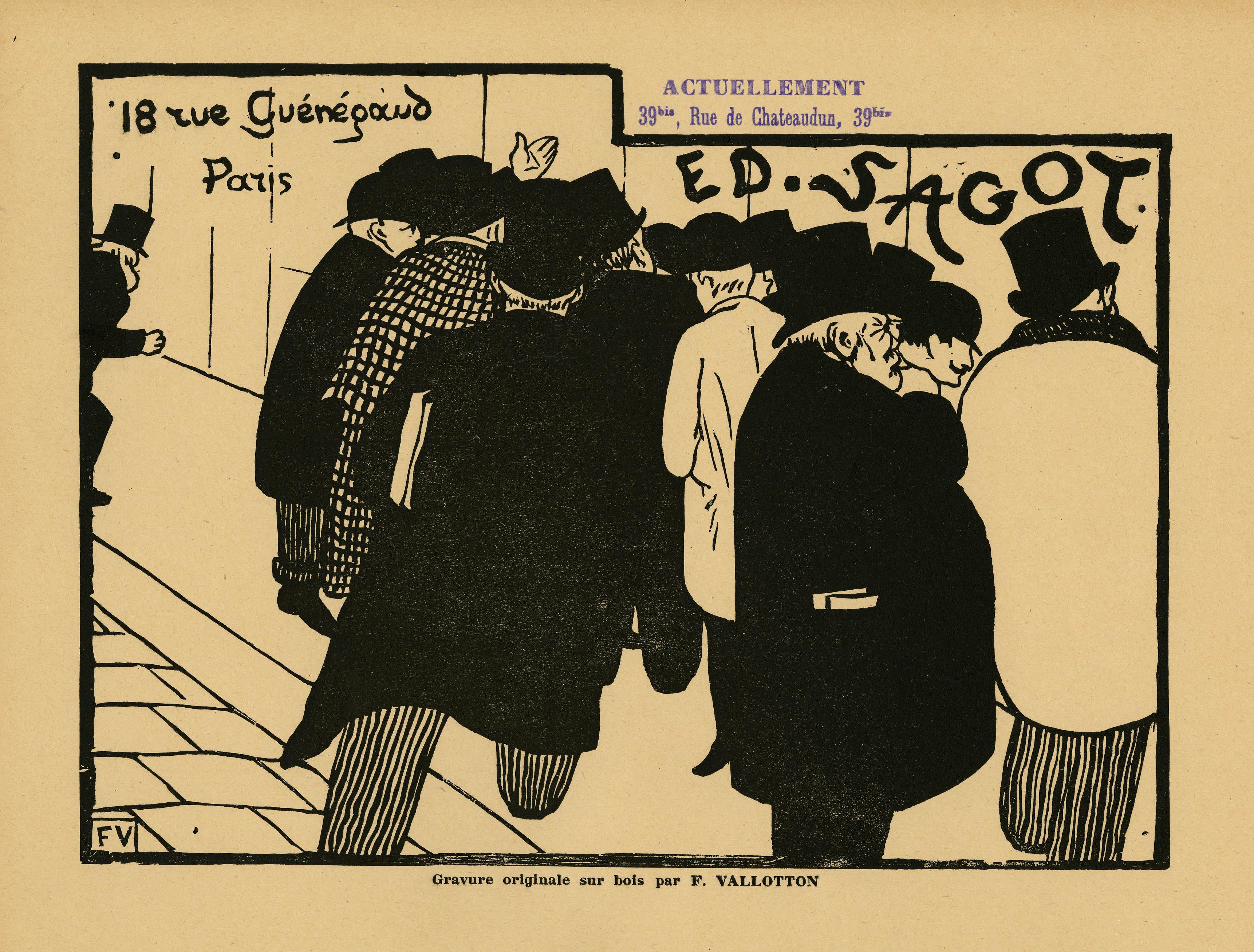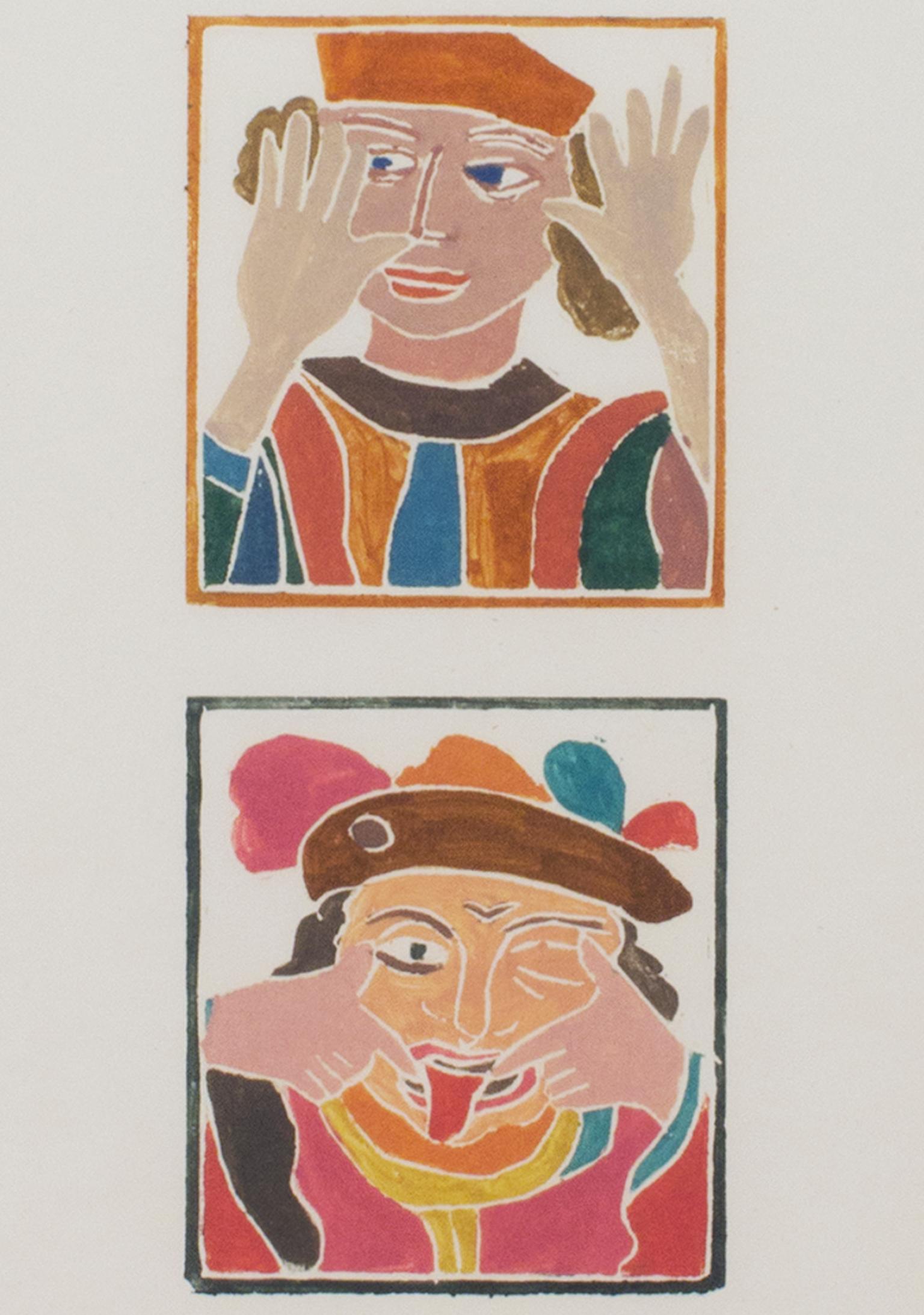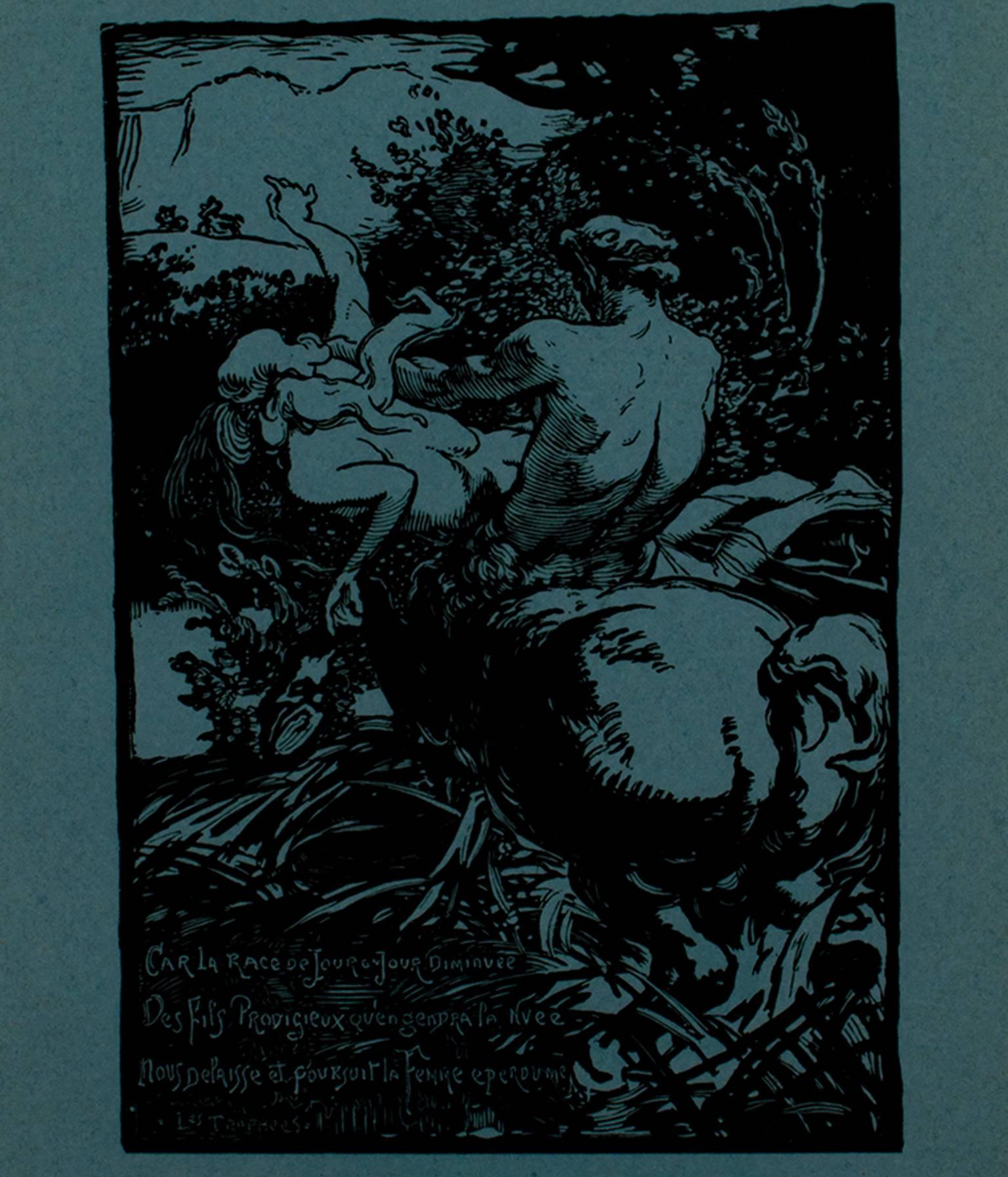Items Similar to Woman Embroidering (Nini) by Lucien Pissarro - Woodcut
Want more images or videos?
Request additional images or videos from the seller
1 of 5
Lucien PissarroWoman Embroidering (Nini) by Lucien Pissarro - Woodcut
About the Item
Woman Embroidering (Nini) by Lucien Pissarro (1863-1944)
Woodcut
15 x 10 cm (5 ⁷/₈ x 4 inches)
Stamped with initials lower right
Numbered lower left, 18/20
Provenance: Private Collection, London
Artist biography:
Born on the 20th February 1863, Lucien Pissarro was the eldest son of the Impressionist painter Camille Pissarro. Coached from a young age by his father and in the frequent company of figures such as Cézanne, Gauguin and Monet, it is no surprise that Lucien chose to pursue an artistic career. While he is best known as a landscape painter, Lucien was also a printmaker, wood engraver and printer of fine books, occasionally painting still lifes and portraits of his family.
Lucien first visited England in 1870 with his family when fleeing the Franco-Prussian war. It was the beginning of a great love affair with the country. He decided to move permanently to England in 1890, becoming an English citizen in 1916. Until then he had worked as a landscape painter and book illustrator in France. During this period he met and worked with painters such as Paul Signac, Georges Seurat and Vincent van Gogh. Moving simultaneously in Impressionist and Neo-Impressionist circles, Lucien exhibited Pointillist paintings with his father in the last Impressionist exhibition in 1886. In the same year he was one of the first artists to exhibit in the “Salon des Indépendants” as a Neo-Impressionist.
Despite his close relationship with his father, as revealed in their correspondence, Lucien showed remarkable independence of mind in his approach to his art. While Lucien was trained by his father, the influence the artists had on one another was reciprocal. Thanks to his relationship with Seurat and Signac, Lucien encouraged Camille to experiment with Pointillism, a characteristic of the Neo-Impressionist group.
Lucien’s move to England in 1890 allowed him greater freedom to pursue his interest in book illustration and printing. There Lucien and his wife Esther established the Éragny Press, named after the Normandy village where his family lived since 1884. The Éragny Press was principally notable for creating aesthetically pleasing books and paved the way for the development of European book art. Lucien’s illustrations for these books demonstrate his talent and command of colour.
Nevertheless, Lucien always considered painting his primary concern, particularly landscape painting. Continuing the tradition of the Impressionists, Lucien was a plein-air painter who liked to work outdoors and study the subject directly from nature. His landscapes reveal his fascination for the effects of weather and light. The contemporary art critic Frank Rutter described Lucien as a master of colour, writing in 1922: “there is no man living who has a more profound knowledge of the science of colour, or a more discriminating eye for its observation in nature.” Rutter was also struck by Lucien’s respect for his subject, nature itself: “Each canvas is wrought with a quiet perfection that conceals its art and is eloquent of the tender emotion which the loveliness of nature inspires in the artist.”
It is clear from Rutter’s praise that Lucien’s contemporaries were impressed by his combination of English and French artistic traditions. Unsurprisingly, he became associated with artistic groups that drew inspiration from the Impressionists, including the New English Art Club, with whom he exhibited in 1904, the Fitzroy Street Group in 1907 and the Camden Town Group in 1911. To his English contemporaries Lucien represented a direct link to the Impressionist Masters. His influence can be recognised in the work of British artists such as Spencer Gore, Harold Gilman and Walter Sickert, who acknowledged Lucien’s influence, writing in 1914: “Mr Pissarro, holding the exceptional position at once of an original talent, and of the pupil of his father, the authoritative depository of a mass of inherited knowledge and experience, has certainly served us as a guide.”
Since his first solo exhibition at the Carfax Gallery in May 1913, Lucien Pissarro’s work has been featured in countless exhibitions and galleries. During his lifetime Lucien donated his estate to the Ashmolean museum in Oxford, where a permanent collection of his work is still housed today. His works are featured in every major art museum in England, as well as the Musée d’Orsay in Paris, the National Gallery of Australia and many museums in the USA.
- Creator:Lucien Pissarro (1863 - 1944, French)
- Dimensions:Height: 5.91 in (15 cm)Width: 3.94 in (10 cm)
- Medium:
- Movement & Style:
- Period:
- Condition:
- Gallery Location:London, GB
- Reference Number:1stDibs: LU261213344442
About the Seller
5.0
Recognized Seller
These prestigious sellers are industry leaders and represent the highest echelon for item quality and design.
Platinum Seller
These expertly vetted sellers are 1stDibs' most experienced sellers and are rated highest by our customers.
Established in 1964
1stDibs seller since 2015
95 sales on 1stDibs
Typical response time: 4 hours
Associations
Society Of London Art Dealers
- ShippingRetrieving quote...Ships From: London, United Kingdom
- Return PolicyA return for this item may be initiated within 7 days of delivery.
More From This SellerView All
- After Tea by Ludovic-Rodo Pissarro - Wood engravingBy Ludovic-Rodo PissarroLocated in London, GBAfter Tea by Ludovic-Rodo Pissarro (1878-1952) Wood engraving 12 x 13.2 cm (4 ³/₄ x 5 ¹/₄ inches) Initialled and titled in the plate Executed circa 1917 Artist biography Ludovic-Rod...Category
1910s Post-Impressionist Figurative Prints
MaterialsWoodcut
- Chatter by Orovida Pissarro - EtchingBy Orovida PissarroLocated in London, GBChatter by Orovida Pissarro (1893-1968) Etching 26 x 19 cm (10 ¹/₄ x 7 ¹/₂ inches) Signed and dated lower right Orovida 1927 Inscribed lower left Trial proof no. 18/25 and titled lower middle Artist biography: Orovida Camille Pissarro, Lucien and Esther Pissarro’s only child, was the first woman in the Pissarro family as well as the first of her generation to become an artist. Born in Epping, England in 1893, she lived and worked predominantly in London where she became a prominent member of several British arts clubs and societies. She first learned to paint in the Impressionist style of her father, but after a brief period of formal study with Walter Sickert in 1913 she renounced formal art schooling. Throughout her career, Orovida always remained outside of any mainstream British art movements. Much to Lucien's disappointment she soon turned away from naturalistic painting and developed her own unusual style combining elements of Japanese, Chinese, Persian and Indian art. Her rejection of Impressionism, which for the Pissarro family had become a way of life, together with the simultaneous decision to drop her famous last name and simply use Orovida as a ‘nom de peintre’, reflected a deep desire for independence and distance from the weight of the family legacy. Orovida's most distinctive and notable works were produced from the period of 1919 to 1939 using her own homemade egg tempera applied in thin, delicate washes to silk, linen or paper and sometimes embellished with brocade borders. These elegant and richly decorative works generally depict Eastern, Asian and African subjects, such as Mongolian horse...Category
1920s Post-Impressionist Figurative Prints
MaterialsEtching
- Man & Beast by Orovida Pissarro - EtchingBy Orovida PissarroLocated in London, GB*UK BUYERS WILL PAY AN ADDITIONAL 20% VAT ON TOP OF THE ABOVE PRICE Man & Beast by Orovida Pissarro (1893-1968) Etching 27 x 22 cm (10 ⁵/₈ x 8 ⁵/₈ inches) Signed and dated lower right, orovida 1924 Inscribed lower left, Final state no 12/40 and titled lower centre Artist biography: Orovida Camille Pissarro, Lucien and Esther Pissarro’s only child, was the first woman in the Pissarro family as well as the first of her generation to become an artist. Born in Epping, England in 1893, she lived and worked predominantly in London where she became a prominent member of several British arts clubs and societies. She first learned to paint in the Impressionist style of her father, but after a brief period of formal study with Walter Sickert in 1913 she renounced formal art schooling. Throughout her career, Orovida always remained outside of any mainstream British art movements. Much to Lucien's disappointment she soon turned away from naturalistic painting and developed her own unusual style combining elements of Japanese, Chinese, Persian and Indian art. Her rejection of Impressionism, which for the Pissarro family had become a way of life, together with the simultaneous decision to drop her famous last name and simply use Orovida as a ‘nom de peintre’, reflected a deep desire for independence and distance from the weight of the family legacy. Orovida's most distinctive and notable works were produced from the period of 1919 to 1939 using her own homemade egg tempera applied in thin, delicate washes to silk, linen or paper and sometimes embellished with brocade borders. These elegant and richly decorative works generally depict Eastern, Asian and African subjects, such as Mongolian horse...Category
1920s Post-Impressionist Animal Prints
MaterialsEtching
- Horse Pulling Hay Cart by Félix Pissarro - Animal etchingBy Félix PissarroLocated in London, GBHorse Pulling Hay Cart by Félix Pissarro (1874-1897) Etching 19.5 x 15 cm (7 ⅝ x 5 ⅞ inches) Exhibition London, Stern Pissarro Gallery, Camille Pissarro & hi...Category
1890s Post-Impressionist Animal Prints
MaterialsEtching
- Procede by Georges Manzana Pissarro - Monotype of a birdBy Georges Henri Manzana PissarroLocated in London, GBProcede by Georges Manzana Pissarro (1871-1961) Coloured monotype with gold, silver and pencil 24 x 30 cm (9¹/₂ x 11³/₄ inches) Signed lower right, Manzana Artist biogaphy Like all ...Category
20th Century Post-Impressionist Animal Prints
MaterialsGold, Silver
- Three Hens by Georges Manzana Pissarro - Animal stencilBy Georges Henri Manzana PissarroLocated in London, GBThree Hens by Georges Manzana Pissarro (1871-1961) Pochoir 31.8 x 48.3 cm (12 ½ x 19 inches) Signed with Estate stamp and épreuve d'état Provenance Private Collection, London Artis...Category
19th Century Post-Impressionist Animal Prints
MaterialsStencil
You May Also Like
- Les Amateurs d'EstampesBy Félix VallottonLocated in Fairlawn, OHLes Amateurs d'Estampes Woodcut, 1892 Initialed in the plate lower left Titled below image: "Gravure originale sur bois par F. Vallotton" Reference: Valloton and Goerg 107c, with the purple address stamp upper right center (see photo) Condition: Excellent Aging to sheet One spot of printers ink outside of the image in the upper margin Block size: 7 3/8 x 10 inches Sheet size: 10 1/8 x 12 3/4 inches Condition: Very good, aging (yellowing) to the paper Provenance: Edmund Sagot (1881-1917), noted Parisian art dealer and print publisher By decent Vallotton was a noted member of the Nabi, highly regarded for his paintings and original woodcuts. His works are in most major museums. Thank you for your interest in the Vallotton woodcut, Les Amateurs d’Estampes (Print Lovers). It depicts print collectors admiring the new offerings in the window of the Sagot Gallery in Paris. The woodcut is the second published version of the address card for Edmund Sagot the noted Paris art gallery with the change of address in lavender ink. It had moved and hence the change of address was necessary for publicity. The woodcut was created in 1892. It is unsigned as all the address cards are. There are two size variants, this being the larger of the two. It is printed on a tan wove paper. It is in excellent original condition. The provenance is from the Heirs of Edmund Sagot (1857-1917). by decent. The Sagot family was noted for selling posters, fine prints and original works of art. Edmund’s brother Clovis, was Picasso’s first dealer in Paris. The image is documented in the Vallotton and Goerg catalog raisonne in entry 107c Impressions of this image can be found in many museums including: Bibliothèque nationale de France De Young/Legion of Honor/Fine Art Museums of San Francisco Newfields, Indianapolis Museum of Art National Gallery of Australia Musee Des Beaux-Arts du Canada Van Gogh Museum Museum of Fine Arts, Houston Portland Art Museum Kunst Museum, Holland Philadelphia Museum of Art Yale University Art Gallery Félix Vallotton, in full Félix Edouard Vallotton, (born December 28, 1865, Lausanne, Switzerland—died December 28, 1925, Paris, France), Swiss-born French graphic artist and painter known for his paintings of nudes and interiors and in particular for his distinctive woodcuts. Vallotton was raised in a traditional bourgeois and Protestant household. After completing secondary school, he left Lausanne in 1882 for Paris to pursue art studies. Though he was accepted by the École des Beaux-Arts, he chose to attend the less traditional Académie Julian, where he studied with French painters Jules Lefebvre and Gustave Boulanger and enjoyed virtually free rein over his pursuits. He took the opportunity to study graphic arts—lithography and other methods of printmaking. He exhibited publicly for the first time in 1885 at the Salon des Artistes Français—the oil painting Portrait of...Category
1890s Post-Impressionist Figurative Prints
MaterialsWoodcut
- Young girl Combing her Hair - Signed Woodcut - Fauve ArtBy Maurice de VlaminckLocated in London, GBMAURICE DE VLAMINCK 1876-1958 Paris 1876-1958 Rueil-la-Gadelière, Eure-et-Loir (French) Title: Young girl Combing her Hair Jeune fille se coiffant, 1906/1957 Technique: Original Hand Signed and Numbered Woodcut...Category
1950s Fauvist Figurative Prints
MaterialsWoodcut
- Set of Four Framed Wood Cut Prints After André DerainBy André DerainLocated in Pasadena, CARare Set of Four Original Color WDCT Skira 1943 after RABELAIS (François). The Horrible and Terrible Deeds and Prowess of the Renowned Pantagruel, King of the Dipsodes, Son of the ...Category
1940s Fauvist Figurative Prints
MaterialsLithograph, Woodcut
- "The Court Jesters, " Two Original Woodcuts by Andre DerainBy André DerainLocated in Milwaukee, WI"The Court Jesters" includes two original color woodcuts by Andre Derain. This is from an edition of 200. It features two vignettes of brightly-clad j...Category
1940s Fauvist Figurative Prints
MaterialsWoodcut
- "Car La Race, Became the Race..., " Woodcut on Blue Paper by Louis LepereBy Auguste Louis LepèreLocated in Milwaukee, WI"Car La Race" is an original woodcut on blue paper by Louis Auguste LePere. It depicts a centaur capturing a nude human woman in a flurry of motion and muscle. 16" x 13 3/8" art 16...Category
1890s Post-Impressionist Figurative Prints
MaterialsPaper, Woodcut
- The ZealotLocated in San Francisco, CAThis artwork titled "The Zealot" c.1950 is an original woodcut by Hungarian/American artist Julius F. Faysash, 1904-1977. It is hand signed, titled and numbered 4/50 in pencil by the artist. The image (woodblock mark) is 10 x 8 inches, framed size is 18 x 15 inches. Custom framed in a wooden grey frame and light beige matting. It is in very good condition. About the artist: Julius F. Faysash was born 1904 in Budapest Hungary. He and his family moved to the United States in 1914. His father, Emanuel Faysash was a cabinet maker and settled in Cleveland Ohio area. A short time later the family moved to Akron, Ohio where Faysash remained the rest of his life. Julius graduated from the Cleveland School of Art and attended Akron University in 1927. He was a founding member of the Akron Society of Artists in 1931 and was the president of the Society in 1934 and 1946. He was an illustrator for the Firestone Company from the 1940's until his retirement from the company in 1969, mainly working in watercolor for this time period. After retirement he began traveling to Mexico 6 months out of the year and began working in oils, acrylics and printmaking. He received an M.F.A. in 1973 from the Instituto Allende/University of Guanajuato, Mexico. He also had further studies under Henry G. Keller and in portraiture with Wayman Adams, Sandor Vago...Category
Mid-20th Century Post-Impressionist Figurative Prints
MaterialsWoodcut
Recently Viewed
View AllMore Ways To Browse
Dior De Rose
Dorothea Tanning Lithograph
Peter Laszlo Peri
Steiner Woodcut
Fernand Leger Mechanic
Jockstrap Vintage
Lawrence Schmidt
Leonard H Mersky
Leonard Mersky
Leroy Neiman Shaq
Lucy Swan
Luigi Kasimir Brandenburg
Magie Noire Vintage
Marc Chagall Le Poisson Bleu
Marc Chagall Romeo And Juliet
Marie Bracquemond
Mizuno Toshikata On Sale
Tennis Vasarely




